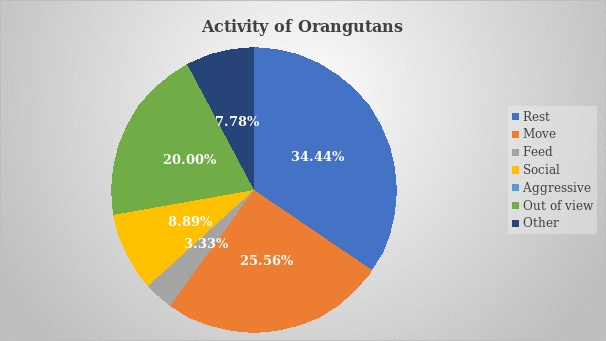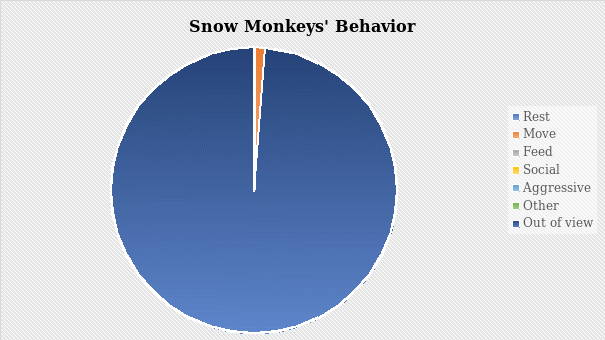Orangutangs
The first species selected for observation are orangutangs in the San Diego Zoo. There are three species of the genus Pongo: Sumatran orangutan, Bornean orangutan, and Tapanuli orangutan (“Orangutan,” n.d.). Orangutangs, also known as red apes, live in the forests of the Southeast Asian islands (“Orangutan,” n.d.). These great apes have long red hair and gray skin (“Orangutan,” n.d.). Orangutans spend most of their time on trees, eating fruits (“Orangutan,” n.d.). They live in small groups and start breeding at the age of 12-15, with children staying with the mother until eight years old (“Orangutan,” n.d.). These apes communicate with each other through touch, facial expressions, and vocalizations.
Methods
I observed orangutangs using the video recording of a live camera shot during the day since I was watching it when the San Diego zoo was closed. I followed the activities of three orangutans and several other siamangs that live with them in the same habitat. The enclosure contains many trees and climbing elements for its inhabitants. However, only the actions of the red apes were scribed every minute for 30 minutes.
Results
Since there were only three orangutans, it was relatively easy to follow their behavior because most were resting, moving, or eating, but occasionally, they socialized or were out of my view. Figure 1 shows the breakdown of their activities in percentages within the 30 minutes of observation. During the brief moments of social interaction, orangutans were grooming each other. Notably, I did not observe any interspecies interaction between orangutans and siamangs.

Primate Activity Profile Data Sheet
- Date: July 24, 2022
- Species: Orangutans
- 3 Animals in the enclosure:
- Male 0
- Female 3
- Juvenile 0
- Observer: Your Name
- Time Begin: 03:00 am
- Rest % – 34.4%
- Move % – 25.6%
- Feed % – 3.33%
- Social % – 8.89%
- Aggress % – 0%
- Other % – 7.78%
- OOV – 20%
- Total – 100%
Snow Monkeys
The species selected for the second observation were the snow monkeys living in the Highland Wildlife Park in Scotland. These apes are the only ones known to bathe in hot springs. They live in the park as one big family that includes monkeys from infantile to older ages (“Snow monkey cam,” n.d.). These monkeys prefer eating greens, monkey pellets, and turnip not individually but always as a group (“Snow monkey cam,” n.d.). Overall, snow monkeys represent a unique species of apes with distinctive white color of hair and red skin.
Methods
The observation was made using a live webcam provided by the Highland Wildlife Park from 5:00 am to 5:30 am GMT-5. I wanted to see this particular type of apes in their natural habitat. Hence, I chose this specific National Park to watch them during the daytime in Scotland. Unfortunately, the view only included the lake and its shores. Still, I could see some snow monkeys moving in groups of two.
Results
Figure 2 represents the percentage breakdown of snow monkeys’ activity during the thirty minutes of observations. The chart shows that most of the time (98.74%), the prevailing number of them were out of view. Only a small percentage (1.26%) rarely moved in front of the camera. Unfortunately, when I observed their activity, I could not watch how they ate, socialized, and cared for their children.

Discussion
Observing two ape species under different conditions showed that distinct and yet similar behavioral patterns can be viewed in captivity and a habitat close to wildlife. For example, watching more variations in the activities of orangutans in the San Diego zoo versus snow monkeys in the Wildlife Park in Scotland was possible. It can be attributed to the latter having more space to explore food; hence, only a few snow monkeys were seen during the 30-minute session. Still, the comparison showed that, in general, monkeys displayed similar behavior.
Primate Activity Profile Data Sheet
- Date: July 24, 2022
- Species: Snow monkeys
- 37 Animals in enclosure:
- Male
- Female
- Juvenile
- Observer: Your Name
- Time Begin: 5:00am
- Rest % – 0%
- Move % – 1.26%
- Feed % – 0%
- Social % – 0%
- Aggress % – 0%
- OOV – 98.74%
- Other % – 0%
- Total – 100%
References
Orangutan. (n.d.). San Diego Zoo.
Snow monkey cam. (n.d.). Highland Wildlife Park.